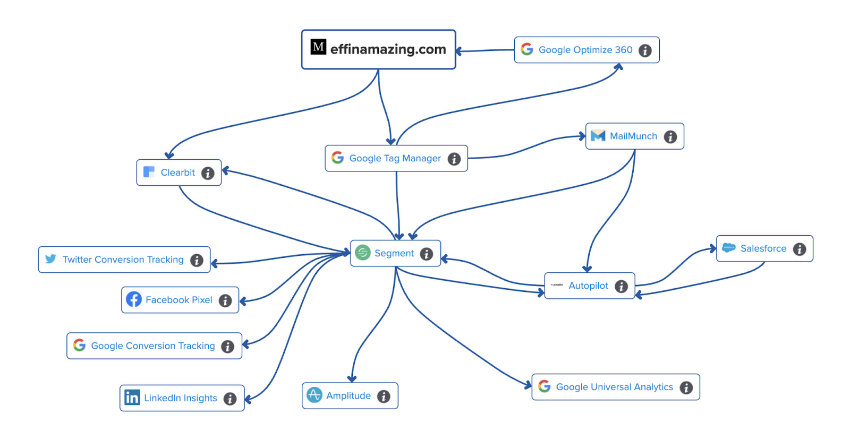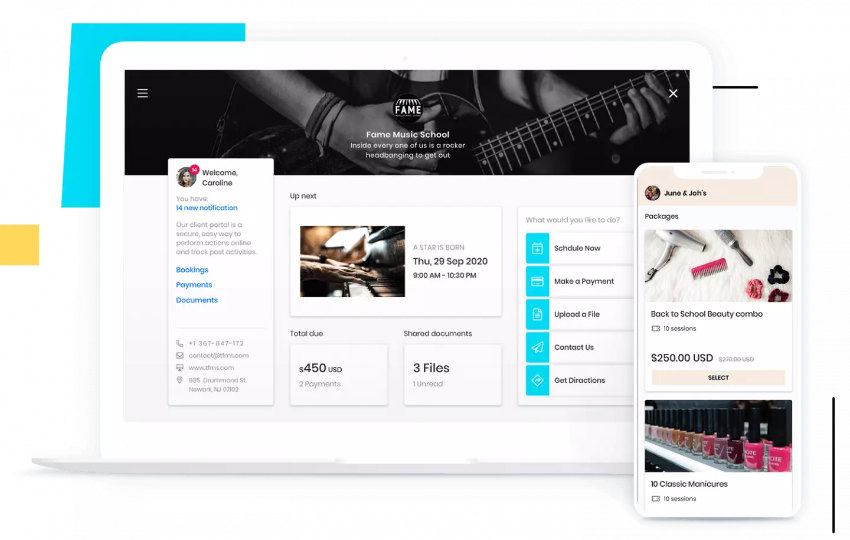Show:
How to Build the Right Tech Stack for Successful Digitalization of Your Small Business
For businesses big and small, the last few years have been a time to “go digital or go home.” With digital natives coming of age as entrepreneurs, software solutions maturing and democratizing, and the pandemic having forced many interactions into virtual spaces, all business operations — from marketing and lead gen to payments and customer service — have largely moved from offline to online.

That’s what digitalization, aka digital transformation, is all about. Gartner defines it as the “use of digital technologies to change a business model and provide new revenue and value-producing opportunities; it is the process of moving to a digital business.”
Process automation, improved customer engagement, greater brand credibility, and stronger team collaboration are some of the many benefits of digital transformation for small businesses. And so, it’s no surprise that 89% of all companies have already or plan to adopt a digital-first business strategy.
Now, a “tech stack” refers to the software tools a company uses to run its operations, such as sales, marketing, accounting, payroll, competitor research, team communication, and customer service. You’re likely already using a few cloud-based digital tools (such as Google Drive) for day-to-day business activities.
In this article, let’s look at the steps you can take to build a robust tech stack for effective digitalization of your small business, followed by some quick tips to do it right.
Small business digitalization process overview
While the exact approach depends on the type of business, here are three key steps for successful digitalization of a small business.
1. Review your current processes and tools
List out the mix of cloud-based software tools your business is already using and the processes around them. Then, try to answer the following:
- Are the tools accelerating or slowing down your workflows?
- Is a particular process too tedious? Can it be simplified?
- Do the tools play well with each other? Or are you spending too much time switching between them and migrating data across them?
Answering these questions will help you identify areas where your tools and processes are hurting — not helping — your efficiency. Each area of inefficiency you pinpoint guides you toward building a better tech stack.
2. Develop a long-term digitalization strategy
Based on the above questions, think about your medium-to-long-run business requirements so that the tools you adopt can scale, in terms of features and pricing, with your business.
To avoid shiny object syndrome — the tendency to constantly chase new trends and tools without evaluating their benefit — you need to create an overarching digitalization strategy for your tech stack.
To do that, think about how you can migrate manual processes that can be automated incrementally over time. For example, if you’re manually sending promotional emails to your clients, then you can consider using an email marketing platform to automate the process and save time with an email sequence scheduled to send based on conditional triggers. You can start off with a simple “welcome” and “happy birthday” email, and then gradually build a complete drip sequence packed with valuable content and offers.
Second, prioritize digitalizing inefficient workflows that can be improved. For instance, if you’re running a brick-and-mortar store and maintaining your client records manually in a diary, then adopting a small business customer relationship management (CRM) software makes sense. It lets you better organize and manage client information for personalized interactions and digital marketing efforts, thus helping you nurture stronger relationships with clients.
Third, think about any outdated tools that you can replace. These can be old, clunky desktop applications that now have better, cloud-based alternatives available which enable better collaboration with your team and/or clients.

Ultimately, when developing a long-term digitalization strategy, consider the following aspects:
- Scalability: The tools you pick should ideally be able to offer additional capabilities as your business expands.
- Integrations: The tools in your tech stack should ideally work together cohesively by integrating with each other. This will help streamline data exchange between the stack and make for smoother workflows. We’ll dive deeper into this in the next section.
- Affordability: Some tools can become too expensive as your business requirements grow. Make sure to consider not just the current pricing plan but also the future pricing options when considering a tool.
3. Reevaluate and optimize your tech stack regularly
Setting up a robust tech stack isn’t a one-and-done deal. As your business grows or changes course, so does the utility of the tools in your tech stack.
Thus, it’s a good idea to reassess your tech stack every six to twelve months in order to:
- Track usage: Which features are being used frequently? Which features are going unused? You might find this data in the tool itself or with a third-party usage tracking tool like Spendflo. Knowing usage metrics helps you decide if you need to upgrade/downgrade your subscription or switch to an alternative tool.
- Identify bottlenecks: Are any of the tools hindering your team’s productivity? Is there a need to provide training to maximize tool adoption? Understanding and fixing snags can help your team work more efficiently.
- Measure the ROI: Are you able to justify paying for the licenses or monthly subscriptions? Are you realizing tangible gains in terms of revenue, team productivity, client satisfaction, etc.? If not, you may be investing in the wrong or unnecessary tools.
Periodic reevaluations help you answer these questions and optimize your tech stack as per your budget and requirements.
Tips for building a tech stack that suits your small business’s needs
Here are some top tips to ensure you invest in the right digital tools that contribute to your business growth.
Make sure it’s customizable in all the ways your team needs
The ability to tailor the tool or its output to meet your team or client’s unique requirements can help improve team productivity and client satisfaction.
Consider an example of the latter. If you’re providing marketing services to your clients, you might be sharing periodic (say, quarterly) reports with your clients about their campaign’s performance and the outcomes of your efforts.
Here, a data reporting tool with superior customization features, such as Databox’s Reports, comes in handy. Databox is a tool that lets you visualize and analyze key performance indicators (KPIs) across all your platforms and channels on a single intuitive dashboard.

With the Reports feature, you can add context and share insights on the performance data in ways your team is already familiar with. You can customize the reports exactly as per your branding (colors, logo, etc.) and set a schedule to automatically export the report daily, weekly, monthly, or quarterly to the client. All this helps you tell a better, more compelling story of the work done and how it impacted business growth — in a way that’s preferable to both your team and clients.
Multi-purpose small business tools often provide killer value
Along the same lines, you want to maximize the value derived from every tool you have in your tech stack.
This essentially means making full use of every feature the tool provides on a frequent basis to carry out various business activities. And so, selecting tools that have many functionalities — each of which serves a defined purpose for your team — represents better value for spend.
For example, a comprehensive small business management app like vcita lets you collect payments, automate invoicing, enable self-service appointment booking, manage clients, send automated reminders, and create email marketing drip campaigns — all from a single platform.

vcita’s client portal feature enables clients to schedule appointments, securely pay for services, share files online, and message your business from any device. Its new “Reports” module lets you measure success by analyzing things like revenue streams, the performance of your marketing campaigns, etc. in real-time. All this means less context-switching for easier workflows and far less need for wrangling with cross-app integrations.
But sometimes single-purpose apps do what they do best
On the flip side, often, there are use cases for which specialized tools that offer a single functionality are the way to go.
For example, plenty of tools offer the feature to shorten URLs, but Bitly has established itself as the go-to URL-shortening service. Unlike most URL shorteners, the tool specializes in only functionalities that relate directly to managing these links, letting you:
- Brand, customize, and share links.
- Track and analyze real-time click data.
- Learn your top referrers and locations, for each link and for all links, in aggregate.
- Build Bitly into your workflow through integrations.

So, when adding tools to your tech stack, consider if there are any important use cases for which dedicated apps exist that are far superior to other multi-purpose tools. Try them out and integrate them into your tech stack if they fit your needs perfectly.
Beware of functionality redundancies
Many tools offer overlapping functionalities. If you’re adopting a new tool for your team, you want to maximize your ROI from it.
For that, carefully review all the features it offers and contrast them with your existing tools. If you find a handful of common features along with functionalities that are going unused in your existing tool, then it might make sense to drop that tool from your tech stack to make room for the new one.
For example, if you’re using HelloSign and want to start using PandaDoc for building proposals, then you might want to drop HelloSign because PandaDoc has its own eSignature modules.
Do your due diligence and check out user reviews
As obvious as this may sound, take the time to thoroughly dig through reviews from experts and real-world users on software review platforms like TrustRadius and G2.
Along with pricing details, you’ll find detailed pros and cons about the tool you’re considering from businesses similar to yours. You’ll also find improvement suggestions and any active bugs that might hinder your workflow. Furthermore, you can ask questions to reviewers as comments, and easily compare the tool you’re considering with its alternatives.

Put simply, don’t just take the brand’s word for it or decide based on a demo/trial. See what your peers say before investing in a tool.
Cross-stack integrations can make or break workflows
The simpler a workflow is, the more efficient your team will be. Constant context-switching from one tool to another hurts productivity.
Even if you’re using a comprehensive, feature-rich tool to take care of multiple tasks, your team may need additional features that may not be available by default in that tool.
That’s where integrations come in.
For example, if you’re a social media marketing agency, you might be using a tool like Buffer to manage the social media projects of multiple clients. While it’s packed with just about everything you need to plan, collaborate, publish, and analyze social media content, your team still needs other tools to create the actual content, such as graphics and videos.
Buffer offers easy integrations with popular content creation and curation tools like Canva, PicMonkey, Scoop.it, and more. The Canva extension, for instance, means you can connect your Canva and Buffer accounts, create or import designs, and publish them to your clients’ social media channels, without having to leave Buffer. You get the best of Canva’s design features and the best of Buffer’s social publishing features in one place — making for a more streamlined workflow.
Final words
The overarching goal of digitalization is future-proofing your business to drive sustainable growth. Put the above-discussed tips into practice to do just that for your budding business.

 Return to Previous Page
Return to Previous Page








